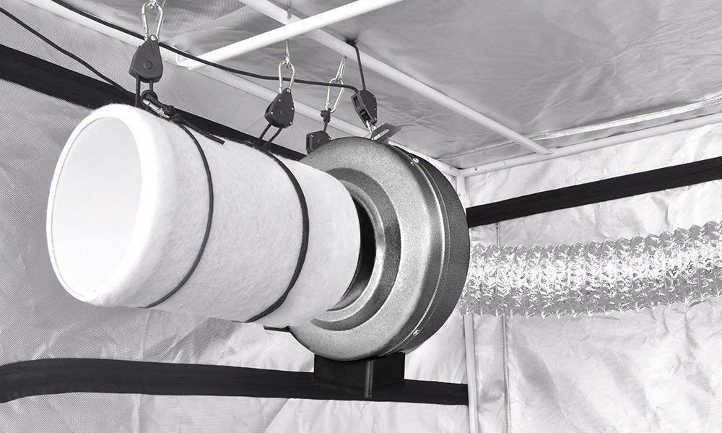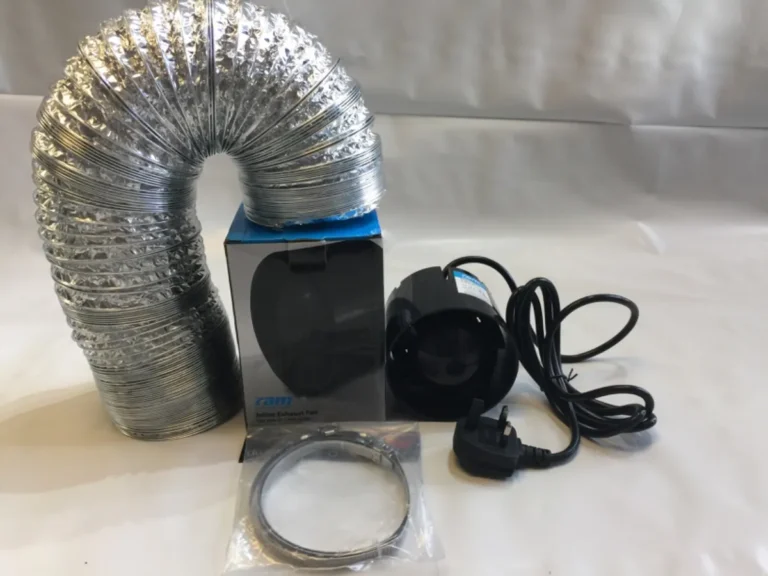An intake fan for a grow tent can be advantageous depending on several factors like tent size, number of plants, ambient temperature, lighting, and existing ventilation. These fans facilitate air circulation, crucial for maintaining proper CO2 levels essential for plant growth and preventing issues arising from stagnant air like increased humidity leading to mold growth. They also aid in regulating the temperature, especially when powerful lights generate excess heat. Additionally, for plants with strong odors, an intake fan equipped with a carbon filter can help mitigate unwanted smells. When selecting an intake fan, it’s vital to match its size to the tent to ensure appropriate airflow without causing excessive noise or disruptive drafts for the plants.
If the current setup already ensures proper airflow and temperature control, an extra intake fan may not be necessary. However, if issues persist with air circulation, temperature, or humidity inside the grow tent, incorporating an intake fan could be a beneficial solution.
What determines the need for an intake fan in a grow tent?

The need for an intake fan in a grow tent is influenced by several factors related to the cultivation of plants indoors. Here are some key determinants:
Ventilation and Air Circulation
Proper air circulation is crucial for plants grown indoors. An intake fan helps to bring in fresh air, which ensures an adequate supply of CO2 for photosynthesis and helps control temperature and humidity levels within the grow tent.
Temperature Control
Plants require specific temperature ranges to thrive. An intake fan assists in regulating the temperature by bringing in cooler air from outside the tent, especially if the internal temperature is getting too high due to lighting or other environmental factors.
Humidity Regulation
Controlling humidity levels is essential for plant health. An intake fan can help manage humidity by bringing in fresh air, which may have a different moisture content than the air inside the tent. This can prevent the buildup of excessive moisture that could lead to mold or mildew.
CO2 Enrichment
Plants require CO2 for photosynthesis. An intake fan can bring in fresh air containing CO2, ensuring that plants have an adequate supply for optimal growth.
Odor Control
In some cases, especially when growing certain plants with strong odors, an intake fan equipped with a carbon filter can help control and minimize odors by pulling air through the filter before it enters the grow tent.
Preventing Stagnation
Stagnant air can lead to issues such as poor nutrient absorption, weak plant structures, and increased risk of pests and diseases. An intake fan helps maintain air movement and prevents stagnation.
Size of the Grow Space
Larger grow tents or spaces may require multiple intake fans or larger, more powerful fans to ensure proper air exchange.
Ultimately, the need for an intake fan in a grow tent depends on the specific environmental conditions, the type of plants being grown, the size of the tent, and the grower’s goals for optimizing plant growth and health.
A well-designed ventilation system, which may include intake and exhaust fans, can play a critical role in creating an ideal growing environment for indoor cultivation.
How do intake fan benefits aid optimal growth conditions?
Intake fans play a crucial role in creating and maintaining optimal growth conditions for plants in various ways:
Ventilation and Air Exchange
Intake fans ensure a continuous flow of fresh air into the grow tent, promoting proper ventilation. This constant exchange of air helps in regulating temperature and humidity levels, preventing the buildup of stagnant air pockets that can hinder plant growth.
Temperature Regulation
The intake fan brings in cooler, fresh air from outside the tent, helping to regulate the temperature within the growing environment. This is especially vital when grow lights or other equipment generate heat that could otherwise raise the internal temperature to levels detrimental to plant health.
Humidity Control
By introducing fresh air into the grow tent, intake fans assist in managing humidity levels. They prevent excessive moisture buildup that can lead to mold, mildew, or other issues that compromise plant health.
CO2 Enrichment
Intake fans facilitate the inflow of carbon dioxide (CO2) from the surrounding environment, which is essential for photosynthesis. A steady supply of CO2 aids in maximizing the plant’s ability to convert light energy into sugars and other nutrients needed for growth.
Odor Management
For plants with strong odors, intake fans, often paired with carbon filters, help control and minimize odors by filtering the air entering the grow tent. This is particularly beneficial for discreet cultivation and preventing unwanted odors from spreading.
Prevention of Stagnation
Intake fans promote air movement within the grow tent, preventing stagnant conditions that can hinder nutrient absorption, weaken plant structures, and increase susceptibility to pests and diseases.
Overall, intake fans contribute significantly to creating an optimal environment for plant growth by ensuring proper air circulation, temperature and humidity regulation, CO2 availability, odor control, and preventing stagnant air—all of which are critical factors for healthy and robust plant development in an indoor setting.
What key considerations exist in selecting a grow tent intake fan?

When selecting an intake fan for a grow tent, several key considerations can significantly impact its effectiveness and suitability for the indoor cultivation environment:
Airflow Capacity
The fan’s airflow capacity, measured in cubic feet per minute (CFM), should match the size of the grow tent. Consider the tent’s volume and the need for adequate air exchange. A fan that can provide enough airflow to refresh the air within the tent several times per minute is ideal.
Size and Compatibility
Ensure the physical size of the fan fits the intake port or ducting of your grow tent. Compatibility with the tent’s intake port size is crucial for proper installation and optimal functionality.
Noise Level
Consider the noise produced by the fan, especially if the grow tent is located in a living area. Select a fan known for quiet operation, particularly if noise is a concern.
Energy Efficiency
Look for fans that are energy-efficient to minimize electricity costs over time. Fans with high efficiency can provide sufficient airflow while consuming less power.
Build Quality and Durability
Choose a fan made from durable materials that can withstand continuous operation and the indoor growing environment’s humidity and temperature fluctuations. Quality construction ensures longevity and reliability.
Additional Features
Some fans come with features like variable speed settings or built-in controllers, allowing for better control over airflow and customization based on specific plant needs and environmental conditions.
Compatibility with Filters
If odor control is a concern, ensure the fan is compatible with carbon filters. This allows you to attach a filter to the intake fan to help manage strong odors produced by certain plants.
Brand Reputation and Reviews
Research reputable brands and read reviews from other growers to gauge the fan’s performance, reliability, and durability before making a purchase.
Budget
Consider your budget and aim for a fan that offers the necessary features and quality within your price range. Balance cost with performance and durability.
By carefully considering these factors, growers can select an intake fan that suits their specific grow tent setup, providing adequate airflow, maintaining optimal environmental conditions, and contributing to healthy plant growth.
FAQ’s
Should I run my exhaust fan in my grow tent all the time?
Running the exhaust fan continuously ensures proper air exchange, regulating temperature, humidity, and CO2 levels, maintaining a healthy environment for plants.
How do you circulate air in a grow tent?
Air circulation in a grow tent is facilitated by using oscillating fans strategically placed to ensure even distribution of fresh air and prevent stagnant pockets.
Can you grow 2 plants in a 2×2 grow tent?
Yes, a 2×2 grow tent can accommodate 2 small to medium-sized plants, but it’s crucial to manage space efficiently and consider plant size and growth requirements.
What is the difference between intake and exhaust fans?
Intake fans draw fresh air into the grow tent, providing ventilation and CO2, while exhaust fans expel stale air, controlling temperature, humidity, and removing odors.
How many CFM do I need for a grow tent?
The required CFM (Cubic Feet per Minute) for a grow tent depends on its size; generally, aim for a fan with a capacity to exchange the tent’s air volume 3-5 times per minute.
Do fans help with humidity in a grow tent?
Yes, fans aid in humidity control by promoting air circulation, preventing moisture buildup, and maintaining consistent levels throughout the grow tent.
Final Words
In conclusion, ensuring proper airflow in a grow tent is crucial for healthy plant growth. Factors like tent size, plant quantity, temperature, and lighting impact whether an intake fan is needed. Using an intake fan can help by improving air circulation, regulating temperature and humidity, and controlling strong odors with a carbon filter.
When choosing an intake fan, it’s important to consider size, noise levels, and compatibility with existing setups. Evaluating these factors will help create an optimal environment for successful plant cultivation in a grow tent.

